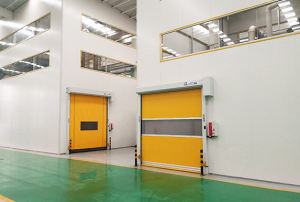Roller shutters, a pivotal component in modern industrial setups, offer an amalgamation of security, environmental control, and efficiency. Particularly, high speed industrial doors have revolutionized the ease with which these systems can be managed, promoting operational fluency without compromising safety. Understanding the mechanisms available for controlling these advanced systems highlights the technological strides this industry has made.
Central to the operation of roller shutters is the use of control panels. These sophisticated units enable the manipulation of high-speed doors from a centralized location. Incorporating features such as one-touch operation and status displays, these panels allow for the seamless raising and lowering of doors, catering to scenarios requiring rapid access or secure closure. Enhanced models offer programmable settings, facilitating tailored operational parameters to suit specific industrial needs.
Remote controllers have also become synonymous with modern roller shutter operation, providing an unmatched level of convenience. Workers in industrial settings no longer need to manually operate heavy doors. Instead, with remote access, they have the power to control these barriers from a distance, a feature that not only enhances physical convenience but also significantly reduces work-related hazards. Especially for environments utilizing high speed industrial doors, this remote functionality promotes a faster response time, crucial during high-traffic operations.

Integration with smart devices is another breakthrough in roller shutter control. With the advent of IoT (Internet of Things) and smart technologies, high-speed industrial doors can now be integrated into a facility’s wider network. This advancement allows for operation via smartphones, tablets, or computers, providing real-time alerts, status updates, and even predictive maintenance information. Such integration is invaluable in maintaining operational continuity and safeguarding against unscheduled downtime.
Moreover, sensory technology introduces an automated aspect to roller shutter control. High speed industrial doors equipped with sensors can automatically detect approaching equipment, such as forklifts, opening instantaneously to allow uninterrupted passage. Post-crossing, these doors can close automatically, minimizing energy loss and maintaining environmental conditions within. These sensor systems are adjustable, ensuring their responsiveness is in line with the pace of workplace activities.
Furthermore, safety controls are an indispensable aspect, particularly in high-traffic or hazardous industries. Systems equipped with emergency stop controls, contactless barriers, and visual or auditory alarms contribute to preventing accidents, ensuring shutters cease movement immediately upon detecting potential risks.
Controlling roller shutters in contemporary industrial environments is a blend of convenience, efficiency, and safety. Through various control mechanisms, ranging from manual panels to automated sensor systems, the operational capacity of these doors is significantly enhanced. As industries evolve, so too do the technologies controlling these vital access points, ensuring they continue to meet the ever-changing demands of fast-paced industrial landscapes.